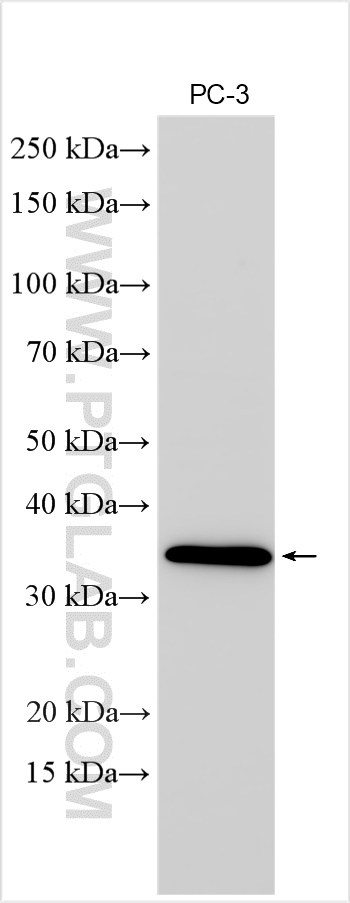验证数据展示
经过测试的应用
| Positive WB detected in | PC-3 cells |
推荐稀释比
| 应用 | 推荐稀释比 |
|---|---|
| Western Blot (WB) | WB : 1:2000-1:16000 |
| It is recommended that this reagent should be titrated in each testing system to obtain optimal results. | |
| Sample-dependent, Check data in validation data gallery. | |
产品信息
30072-1-AP targets TSPAN13 in WB, ELISA applications and shows reactivity with human samples.
| 经测试应用 | WB, ELISA Application Description |
| 经测试反应性 | human |
| 免疫原 | TSPAN13 fusion protein Ag32345 种属同源性预测 |
| 宿主/亚型 | Rabbit / IgG |
| 抗体类别 | Polyclonal |
| 产品类型 | Antibody |
| 全称 | tetraspanin 13 |
| 别名 | Tspan-13, Transmembrane 4 superfamily member 13, TM4SF13, Tetraspanin-13, Tetraspan NET-6 |
| 计算分子量 | 204 aa, 22 kDa |
| 观测分子量 | 28-35 kDa |
| GenBank蛋白编号 | BC033863 |
| 基因名称 | TSPAN13 |
| Gene ID (NCBI) | 27075 |
| RRID | AB_2935509 |
| 偶联类型 | Unconjugated |
| 形式 | Liquid |
| 纯化方式 | Antigen affinity purification |
| UNIPROT ID | O95857 |
| 储存缓冲液 | PBS with 0.02% sodium azide and 50% glycerol , pH 7.3 |
| 储存条件 | Store at -20°C. Stable for one year after shipment. Aliquoting is unnecessary for -20oC storage. |
背景介绍
TSPAN13 (also known as NET6 or TM4SF13) is a membrane protein of the tetraspanin superfamily, which are characterized by the presence of four conserved transmembrane regions. Many of these members have been implicated in signal transduction, cell-cell interactions, and cellular activation and development. Overexpression of TSPAN13 has been reported in prostate cancer, suggesting that TSPAN13 may have an important role in the progression of prostate cancer (PMID: 19148481). The experimentally determined molecular mass of 28-35 kDa is larger than the calcular molecular weight of 22 kDa, which could be a result of post-translational modifications (PMID: 23648579).
实验方案
| Product Specific Protocols | |
|---|---|
| WB protocol for TSPAN13 antibody 30072-1-AP | Download protocol |
| Standard Protocols | |
|---|---|
| Click here to view our Standard Protocols |
